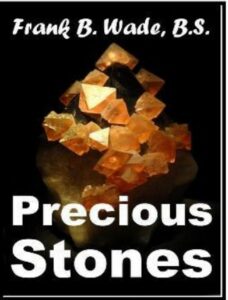PRECIOUS STONES
FOR JEWELERS
and
THE GEM-LOVING PUBLIC
BY
FRANK B. WADE, B.S.

PRECIOUS STONES – BECAUSE of the rapid increase in knowledge about precious stones on the part of the buying public, it has become necessary for the gem merchant and his clerks and salesmen to know at least as much about the subject of gemology as their better-informed customers are likely to know.
In many recent articles in trade papers, attention has been called to this need, and to the provision which Columbia University has made for a course in the study of gems.
The action of the National Association of Goldsmiths of Great Britain in providing annual examinations in gemology, and in granting certificates and diplomas to those who successfully pass the examinations, has also been reported, and it has been suggested that some such[vi] course should be pursued by jewelers’ associations in this country.
The greatest difficulty in the way of such formal study among our jewelers and gem merchants is the lack of time for attendance on formal courses, which must necessarily be given at definite times and in definite places.
As a diamond salesman was heard to say recently: “The boss said he wanted me to take in that course at Columbia, but he didn’t tell me how I was going to do it. Here I am a thousand miles from Columbia, and it was only six weeks ago that he was telling me I ought to take that course.
I can’t stay around New York all the time.” Similarly, those whose work keeps them in New York might object that their hours of employment prevented attendance on day courses, and that distance from the university and fatigue prevent attendance on night courses. The great mass of gem dealers in other cities must also be considered. [vii]
It will therefore be the endeavor of this book to provide guidance for those who really want to make themselves more efficient in the gem business, but who have felt that they needed something in the way of suggestion regarding what to attempt, and how to go about it.
Study of the sort that will be suggested can be pursued in spare moments, on street cars or elevated trains, in waiting rooms, or in one’s room at night. It will astonish many to find how much can be accomplished by consistently utilizing spare moments. Booker T. Washington is said to have written in such spare time practically all that he has published.
For the practical study of the gems themselves, which is an absolutely essential part of the work, those actually engaged in the trade have better opportunities than any school could give and, except during rush seasons, there is plenty of time during business hours for such study.
No intelligent employer will begrudge such use of time for which he is paying, if the[viii] thing be done in reason and with a serious view to improvement. The frequent application of what is acquired, as opportunity offers, in connection with ordinary salesmanship, will help fix the subject and at the same time increase sales.
Many gem dealers have been deterred from beginning a study of gems because of the seeming difficulties in connection with the scientific determination of the different varieties of stones.
Now science is nothing but boiled-down common sense, and a bold front will soon convince one that most of the difficulties are more apparent than real. Such minor difficulties as exist will be approached in such a manner that a little effort will overcome them.
For those who are willing to do more work, this book will suggest definite portions of particular books, which are easily available, for reference reading and study—but the lessons themselves will attempt to teach the essential things in as simple a manner as is possible. [ix]
Perhaps the first essential for the gem merchant is to be able surely to distinguish the various stones from one another and from synthetic and imitation stones.
That such ability is much needed will be clear to anyone who in casting a backward glance over his experience recalls the many serious mistakes that have come to his knowledge. Many more have doubtless occurred without detection. Several times recently the author has come across cases where large dealers have been mistaken in their determination of colored stones, particularly emeralds.
Only the other day a ring was brought to me that had been bought for a genuine emerald ring after the buyer had taken it to one of the dealers in his city and had paid for an examination of it, which had resulted in its being declared genuine.
On examining the stone with a lens of only moderate power, several round air bubbles were noted in it, and on barely touching it with a file it was easily scratched. [x] The material was green glass.
Now, what was said about the dealer who sold it and the one who appraised it may be imagined. The long chain of adverse influence which will be put in action against those dealers, even though the one who sold the stone makes good the loss, is something that can be ill afforded by any dealer, and all this might have been avoided by even a rudimentary knowledge of the means of distinguishing precious stones. The dealer was doubtless honest, but, through carelessness or ignorance, was himself deceived.
Our first few lessons will therefore be concerned chiefly with learning the best means of telling the different stones from one another.
A Text-Book of Precious Stones
HOW STONES ARE DISTINGUISHED FROM ONE ANOTHER
Precious Stones Distinguished by their Properties. One precious stone is best distinguished from another just as substances of other types are distinguished, that is to say, by their properties. For example, salt and sugar are both white, both are soluble in water, and both are odorless. So far, the italicized properties would not serve to distinguish the two substances.
But sugar is sweet while salt is salty in taste. Here we have a distinguishing [2] property. Now, just as salt and sugar have properties, so have all precious stones, and while, as was the case with salt and sugar, many precious stones have properties in common, yet each has also some properties which are distinctive, and which can be relied upon as differentiating the particular stone from other stones.
In selecting properties for use in distinguishing precious stones, such properties as can be determined by quantity, and set down in numbers, are probably more trustworthy than those that can be observed by mere inspection. Those also which have to do with the behavior of light in passing through the stone are extremely valuable.
Read Much More Inside…
DOWNLOAD “PRECIOUS STONES” $34

Click on the Red Button Below for Instant Access!
Our 100% Money Back Guarantee:

If for any reason you decided within 30 days that “PRECIOUS STONES” isn’t for you, simply notify us by email and we’ll gladly refund your money – no questions asked. That’s our Ironclad Guarantee!
The risk is entirely ours! You absolutely have nothing to lose!
Your name and email will Never be shared, sold, or given to anyone.
We keep our subscriber’s privacy sacred. We do not sell or rent your personal information to other parties. What’s more you can always unsubscribe at any time!
Regards,
Coyalita Linville
Copyright © 2021-2023 ttfnicheincomecoyalita.com. All Rights Reserved Privacy Policy – Earnings Disclaimer – Terms of Use – Contact Us
